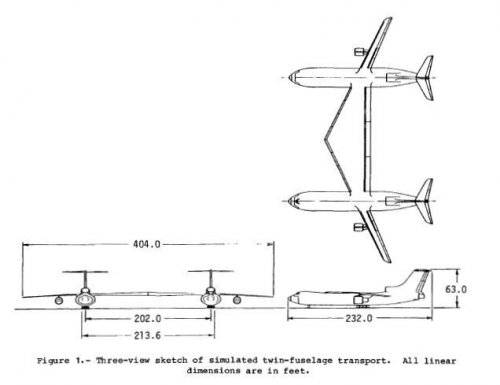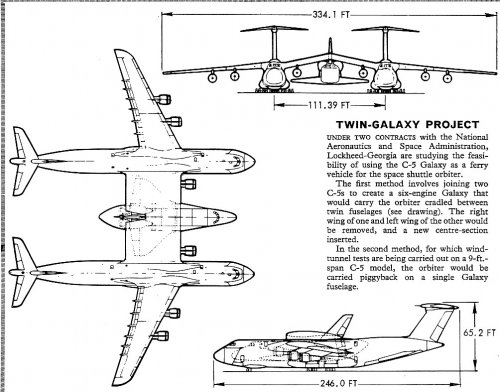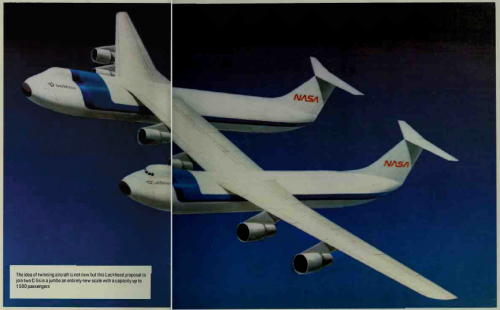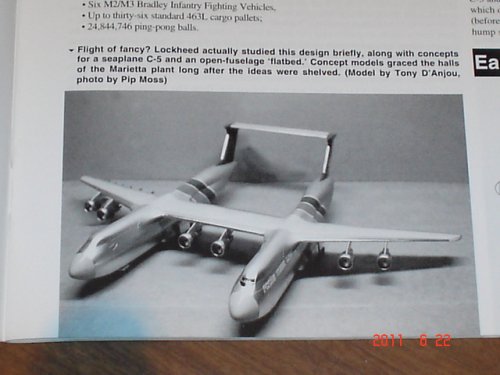You are using an out of date browser. It may not display this or other websites correctly.
You should upgrade or use an alternative browser.
You should upgrade or use an alternative browser.
Twin fuselage Lockheed C-5 Galaxy
- Thread starter hesham
- Start date
- Joined
- 13 August 2007
- Messages
- 7,469
- Reaction score
- 7,522
where is the advantage of this approach ? ? ?
alone the static problems of this big wing with 2 fuselage...
alone the static problems of this big wing with 2 fuselage...
Tophe
ACCESS: Top Secret
from page 2 of Hesham's link:Michel Van said:where is the advantage of this approach ? ? ?
alone the static problems of this big wing with 2 fuselage...
"A disadvantage of the all-wing (span loader) design is the very large size required by the low wing loading t accommodate a given payload. As a possible means of avoiding this disadvantage, an alternate design approach - the multibody - is currently under study. Such designs u t i l i z e two or more discrete bodies to contain the payload which are so located along the wing span to realize substantial bendingmoment relief and, therefore, "maintain" much of the wing-weight advantage of the all-wing span loader. capacity, it is believed possible to use the volume of the smaller bodies more efficiently and thereby compensate for the inherent wetted-area and weight disadvantages of providing the same total volume in two or more bodies rather than a single body."
Michel Van said:where is the advantage of this approach ? ? ?
Primarily reducing the bending moment on the wing. Instead of one very heavy point weight at the middle of the wing, a multi-body design has two or more smaller point weights distributed across the wing. The end result is that either the wing is a lot stonger, or for the same strength it can be a lot lighter. obvious disadvantages are added drag and the need for very wide runways.
Jos Heyman
ACCESS: Top Secret
- Joined
- 15 February 2007
- Messages
- 597
- Reaction score
- 62
I recall that the twin Galaxy was considered as an option to transport the Space Shuttle. The proposal was made before the Space Shuttle flew.
OM
ACCESS: Top Secret
Orionblamblam said:Primarily reducing the bending moment on the wing. Instead of one very heavy point weight at the middle of the wing, a multi-body design has two or more smaller point weights distributed across the wing. The end result is that either the wing is a lot stonger, or for the same strength it can be a lot lighter. obvious disadvantages are added drag and the need for very wide runways.
...Another disadvantage is that airports are designed for single-fusilage vehicles. Therefore, the support infrastructure in addition to the runways would also have to be extensively modified to take advantage of a dual or even triple-bodied airliner. For example, a dual-fuselage 747 would have passengers on both sides, but passenger loading and unloading would require not one but two boarding gate facilities, one for each side. This would necessitate the two gates being located a specific distance opposite one another, thus requiring twice the manpower on the airline's side to coordinate boarding operations unless the two gates were designed so that they met in a "Y" shape, which if you look at today's airports would actually reduce the number of planes that could be docked at one time, etc, etc, etc.
...Yeah, logistics like this are usually the one thing that's left out when discussing planes that are different from the current form factor airplanes. This was one of the things one of the Air Farce ROTC instructors pointed out when he gave a talk to our NROTC class on air support logistics(*). The example he gave was the Flyiing Wing, and how the change in support facilities was one of the factors in addition to the performance issues as why it got canned. This was also where I'd first heard about the Convair B-60 proposal, and how Convair tried to showcase the ability to use all existing B-36 facilities to support the B-60. Granted, this didn't work, and the B-52 was selected, but it was an example of things that have to be taken into consideration where transportation support are concerned.
(*) AKA an attempt to get us to jump ship and switch to the Air Farce. Yeah, riiiight...
Hoo-2b-2day
ACCESS: Confidential
- Joined
- 27 February 2008
- Messages
- 65
- Reaction score
- 11
Tophe
ACCESS: Top Secret
This 6-engined twin-Galaxy project of 1975 is far more famous than the 4-engined twin-fuselage of 1983 found by Hesham. Both make a pleasant family together anyway... 
taildragger
You can count on me - I won a contest
- Joined
- 2 November 2008
- Messages
- 386
- Reaction score
- 449
Orionblamblam said:Michel Van said:where is the advantage of this approach ? ? ?
Primarily reducing the bending moment on the wing. Instead of one very heavy point weight at the middle of the wing, a multi-body design has two or more smaller point weights distributed across the wing. The end result is that either the wing is a lot stonger, or for the same strength it can be a lot lighter. obvious disadvantages are added drag and the need for very wide runways.
In the case of the C-5Z (Zwilling) shuttle carrier, I don't think the improved span loading was a big factor. In it's intended role, the payload (the orbiter) would still be on the centerline and the center wing would be subjected to nearly the same bending loads as a single fuselage layout. The fuselages would probably not be used for payload - with the orbiter aboard, there'd probably be little lifting capacity left. I'd guess that costs would prevent development of capability to carry significant payload in the fuselages without the orbiter aboard. They'd function as really big, really heavy tail booms / landing gear fairings.
The main benefit of the C-5Z approach would have been lowered development costs - it allowed the use of major components without redesign - and a big empty place in the middle. If the fuselages were used without redesign (lightening the structure and reducing drag to exploit the lack of internal payload) the result would probably be less efficient structurally than a properly designed single fuselage design.
- Joined
- 26 May 2006
- Messages
- 33,049
- Reaction score
- 12,647
kitnut617 said:I would have thought this photo of the model which was displayed in the Lockheed front foyer for years would have appeared here by now
Amazing Model,thank you Kitnut617.
- Joined
- 26 May 2006
- Messages
- 33,049
- Reaction score
- 12,647
Similar threads
-
Lockheed-Georgia Advanced Light Aircraft and Helicopters of 1970s
- Started by hesham
- Replies: 2
-
Lockheed Intraurban Transportation Studies
- Started by hesham
- Replies: 5
-
-
Twin fuselage subsonic transport concept
- Started by hesham
- Replies: 2
-








